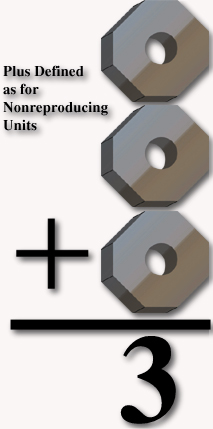Plus Defined for Nonbiological and Biological Math
In any mathematical equation that is standard throughout life in lower grades of elementary school the plus unit is predefined as for nonreproducing and nondivisible inanimate or animate objects. When one is utilizing products which can degrade, divide, and reproduce the symbol plus must be further defined along with the rules for the equations which is found in further definitions that no longer can such units as monkeys and oranges be added as they are not the same species.
In products which degrade we have also the requirement to define how far we will measure its degradation product. Where as in laboratory mathematical equations where the numbers may exceed the calibration or sensitivity of the instrument this is an additional consideration which over rules significant digits. Which can further confuse the learning medical laboratory student if not clearly defined and redefined as each instrument may have a different level of sensitivity.
To begin with I will show a basic nonreproducing, nondegrading, nondivisible unit (under normal circumstances such as not relating to any microbial growth unpon the objects used in the first example).

When one takes the plus symbol into biological units it obtains more of a division or multiplicative behavior.
In the case of reproducing bodies we must consider the fertility, the type such as male or female, the numbers, the amount of food available to sustain life and reproduction, the amount of needed constituents (such as living space, oxygen, decomposition of waste space, etc.), health of the organisms, and so forth. All things possible need to be considered.
In the lower life form the reproduction is by binary fission where the organism doubles by replication all of its constituent parts and then divides. This is how most unicellular forms even the cells of multicellular organisms reproduce. So in lower life forms one may equal zero if there is not enough required sustanance or it may equal an infinite number if the condition is optimum.
In some smaller life forms reproduction is not limited to the input of one organism but may be affected by many through the sharing of DNA information in the form of plasmids. This may cause a differentiation of the species or strain to the extent that microbe A plus microbe B may equal an infinite number of microbe C. Or even A plus B plus C equals and infinite number of D or a nonfunctional D - Zero eventually.
In reproducing unit that require the genetic input of two different organisms they must first be genetically viable, healthy, have all the necessary sustanance for reproduction addition. When these things are assured one plus one may equal three as the first and second organism produce a third organism. The equation would be as such A plus B equals A plus B plus C(n+1). For example one panda plus one panda equals three pandas - then plus is defined as if and only if the pandas in the first part of the equation are of the opposite sex, it is mating season, they are both fertile, the female survives through birth, and the offspring is born alive.
This further defines the Biblical saying by God to humans go forth and multiply. To have simply one child is to increase the numbers by a multiplicative factor. In the case of any organism to even have one offspring is to have a multiplicative factor. God said go forth and multiply. God did not say go forth and exponentiate.
There is a laboratory experiment that is taught to most genetic students. It is called the fruit fly curve. Three fruit flies of opposite gender are placed in a jar with plenty of food, air, and water. This is to ensure that at least one of each is fertile. After a time the population reaches a peak in an exponential curve. Then suddenly when there is still plenty of air, food and water the entire population dies. This is caused by their having polluted their environment.
In humans we tend to controll our overpopulation in similar manners. Whenever the population becomes very large we either have plagues which tend to wipe out a considerable number of the population or wars which tend to wipe out some of the healthiest and best of our genetics thus weakening the genetics of the human race. Also by elminating the diversity of our DNA we make ourselves more vulnerable to the attacks of pathogens who then do not have to learn a new genetic code every time they invade a human. If all the DNA is the same the first time the organism passes through a member of the species the next one can be affected more strongly until eventually the entire group could quite possibly become extinct.
Return to Eeiren's Home Pages
Tripod's Free Home Pages and Surf Point
I must give credit to my father, my sisters, my nieces, relatives,
friends, all the great knowledgeable people who have written books and
college or universities classes who have either shared directly or
indirectly with me the above shortened version of what they taught me.